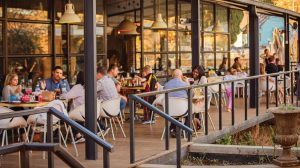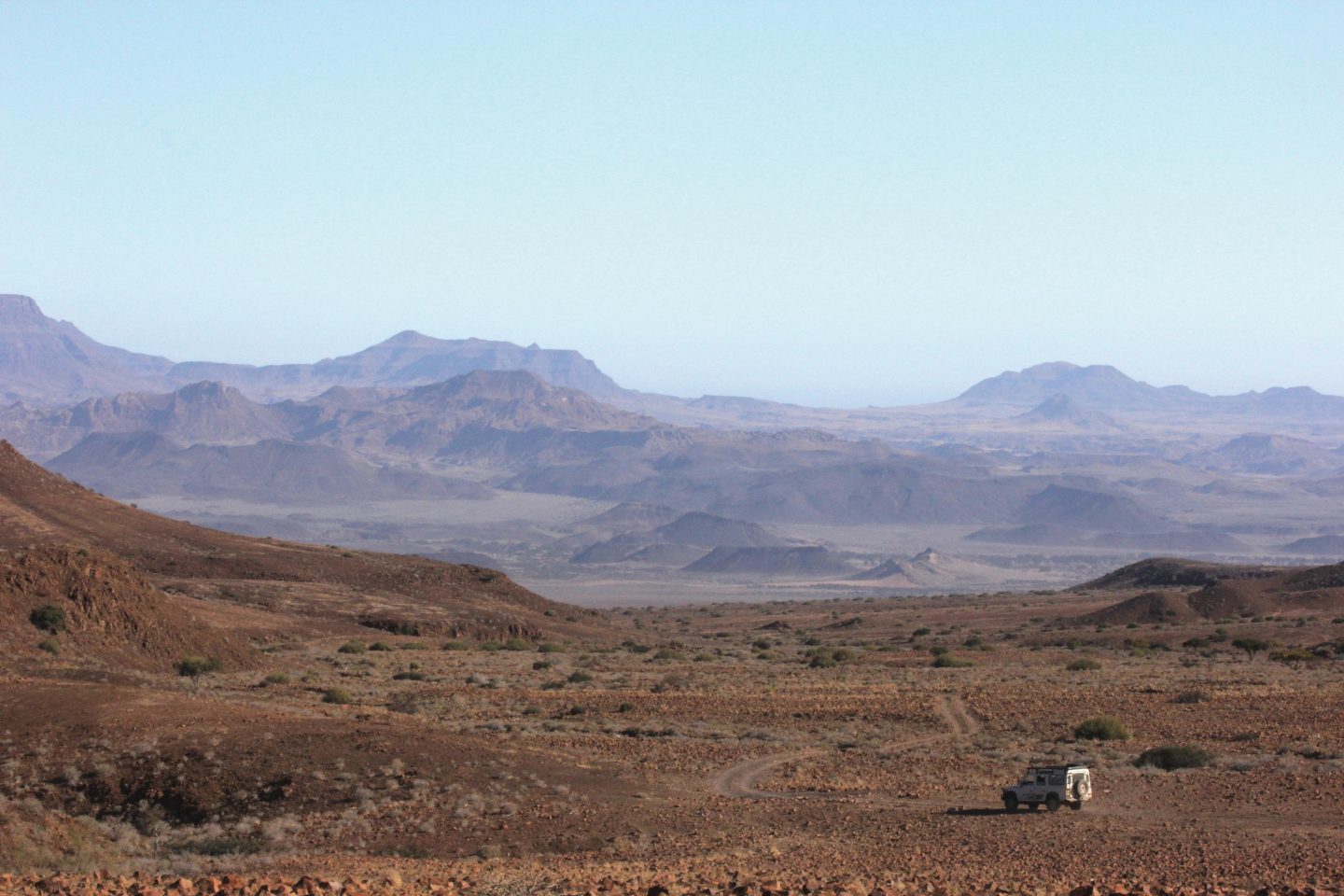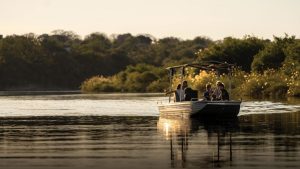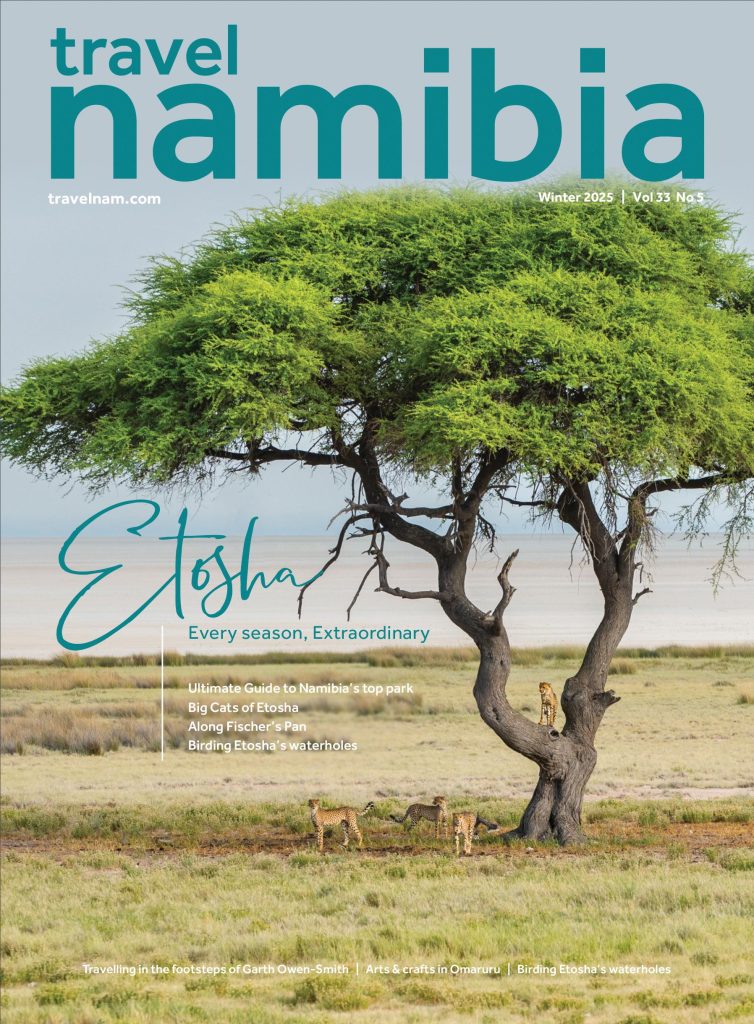

Travelling in the footsteps of a
conservation legend
Northwestern Namibia is not your average travel destination. In my two years of living like a desert nomad in this remote corner of the country, I encountered many self-driving tourists that would have benefitted greatly from an expert guide. From the Italian couple who couldn’t work out how to get the spare wheel off their car to replace a flat, to the Frenchman stranded in the Skeleton Coast, I was constantly reminded that this area could be dangerous.
Text Gail Thomson
From the Winter 2025 issue
In my own travels, I often wondered which were the best tracks off the main road to explore in search of wildlife and scenic spots. Some of my questions were answered when I had the rare privilege of driving in a two-car convoy with the renowned Garth Owen-Smith in 2012. Garth knew the Kunene like a local – he had explored it thoroughly during his many years as a nature conservationist while helping to establish Namibia’s communal conservancies, which still operate today.
The weekend trip down the dry Huab River with Garth and his friends is one of my fondest memories of the Kunene. We were hot on the heels of a desert-adapted lion, which somehow managed to elude us. Yet the stunning landscapes and other wildlife we saw more than made up for the evasive lion. Listening to Garth’s stories of his career in conservation would have made the trip worth it, even if I had seen nothing else.
Garth’s legacy lives on since he succumbed to cancer in 2020, particularly through the efforts of his life partner Dr Margaret Jacobsohn. Margie continues to run a safari company that she and Garth helped to establish, known as Conservancy Safaris Namibia (CSN). This small company was structured differently to most tour operations. True to their values, Garth and Margie supported CSN because it is co-owned by the people living in five conservancies in the Kunene Region. Many of these ovaHimba and ovaHerero people worked with Garth and Margie during the early years of the community conservation movement, and a few of Margie’s personal friends remain to this day.
My first encounter with CSN (at the time, known as Kunene Conservancy Safaris) was during one of my stays at Wêreldsend (translated: end of the world). This aptly named camp and education centre is the Kunene field headquarters for the Integrated Rural Development and Nature Conservation (IRDNC), an organisation established by Garth and Margie. The camp is not open to the general public, and I was only there by special permission.
As I was sitting by my tent at Wêreldsend, I looked up to see the CSN team arriving in their 4×4 vehicle. This team goes ahead of their guests to set up camp – including large dome tents, comfortable bedrolls, portable showers and toilets. The chef started a fire and prepared the evening meal while the finishing touches were added to their impressive camp. Since I spent a lot of time setting up and breaking down camp in those nomadic days, I looked on their comfortable camp with more than a touch of envy. This only increased when I realised that their guests were on a multi-day expedition led by the one-and-only Garth Owen-Smith!
“Listening to Garth’s stories of his career in conservation would have made the trip worth it, even if I had seen nothing else.”
Garth left a gaping hole in the world of nature conservation that is difficult to fill. CSN’s expert guides have nonetheless taken on his community-based tourism efforts with aplomb. Boas Hambo, their main expedition guide, worked closely with Garth and well-known conservationist Russell Vinjevold for many years. Boas started his career in community conservation and has become an expert in his own right; he helped train many of the conservancy rhino rangers. Having grown up in the Kunene, Boas speaks all the local languages and navigates the rocky roads with consummate ease. His close connections with the people and the land are evident as he takes his guests to places that few other guides even know about. His expert translation allows you to talk to people and opens up a world you would never otherwise know exists.
While each CSN safari is tailored according to up-to-date knowledge of wildlife movements and the guests’ specific requests, the expedition would not be complete without a few nights at CSN’s iconic Etaambura Lodge. Made from local stone, canvas and thatch, the lodge and five en suite chalets are perched on a mountaintop that boasts stunning 360-degree views of the mountainous desert landscape.
The mountains in the Kunene are known for their unique plant species, and Etaambura’s location is no different. Since the lodge was built to make the minimum possible impact on the environment, these beautiful plants are still thriving along the pathways between the chalets and the main lodge. Each chalet and its private deck is situated to make the most of the views while fitting around the natural rocky outcrops.
Having heard about Etaambura from Garth but being unable to visit during my few years working in the region, I decided to make it a priority stopover when guiding some friends through the Kunene in 2015. It did not disappoint! After several days of driving – including some challenging 4×4 tracks – we were only too glad to rest for a few nights and absorb the views and absolute stillness of Etaambura. For guests who are used to light-polluted cities, the starry nights are simply astonishing.
One of the unique features of both CSN and Etaambura is their relationship with the ovaHimba. The staff are friends and family of the people living in the area, resulting in a guest experience with these famously ochre-red people that goes beyond a few posed photos.
During a recent trip to Etaambura with Margie, we met some of the people living in the small villages below the lodge. They welcomed us as friends-of-friends, rather than strangers from distant places. Our guide Henry introduced us to his mother and sister, who still choose to dress and live traditionally. They were only too happy for us to walk around their traditional village and take photos. Guests who want to spend more time with these enchanting people are welcome to book a traditional dinner with an ovaHimba family, or enjoy such a meal at the lodge, expertly prepared by Henry or by lodge manager Kakuu, a Himba woman who spent two years living in England. Her fire baked bread is unforgettable!
“You are travelling in the footsteps of a conservation legend whose love for this special place and people lives on in the memories of everyone you meet.”
Later that day, we met Henry’s friend and his young son trying to water their herd of goats. They were only too grateful to see Henry, who helped to haul water out one of the deep hand-dug pits in the river bed to fill the trough. The little boy did a fantastic job of herding, but hauling water out of the pit is a two-man job. This is a tough way of life, especially during the recent multi-year drought, yet these people are incredibly resilient and hardworking.
Touring the Kunene with CSN is an adventure of a lifetime. But it is even more than that – you are travelling in the footsteps of a conservation legend whose love for this special place and people lives on in the memories of everyone you meet. TN
To find out more about Conservancy Safaris Namibia, visit conservancysafarisnamibia.com






